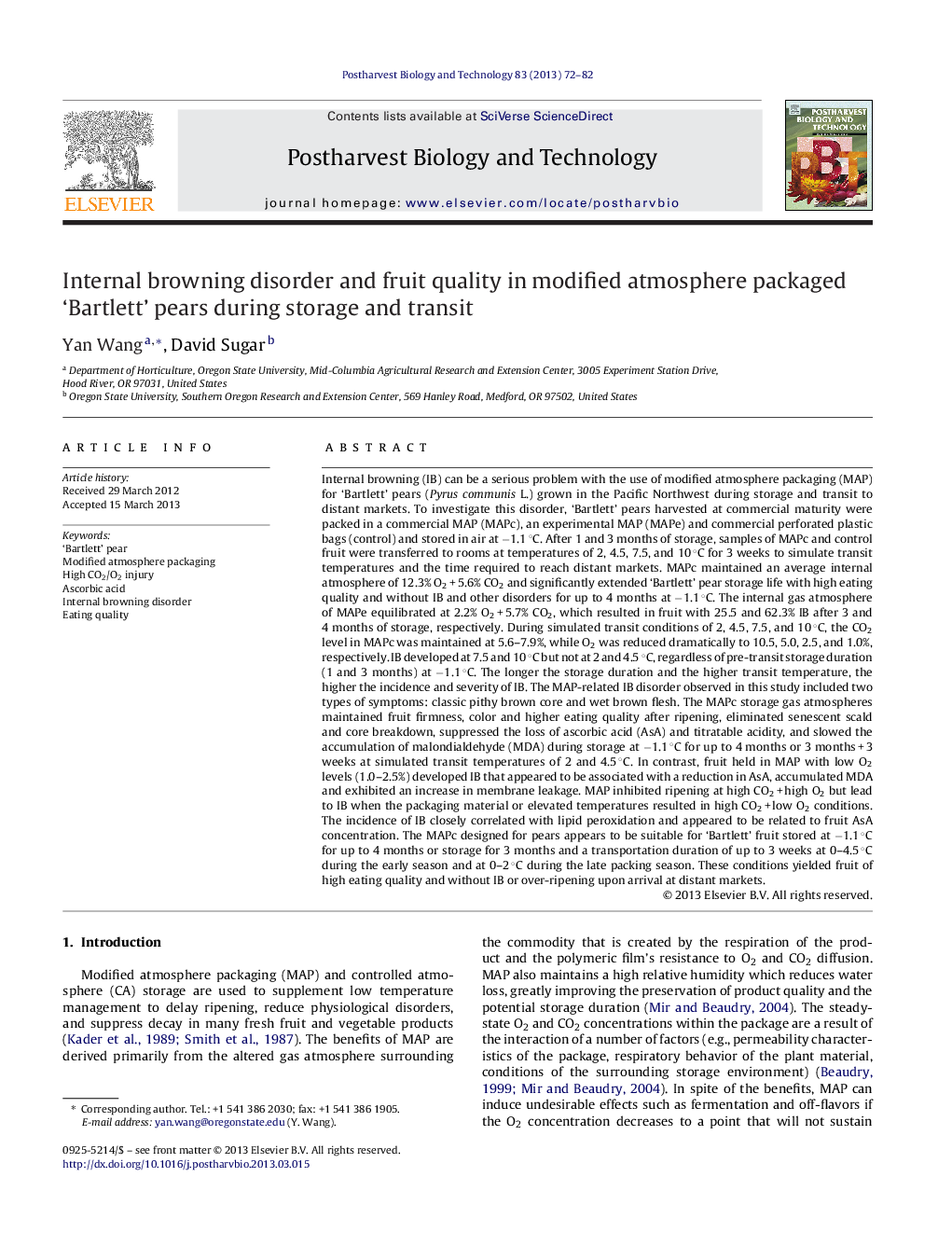| کد مقاله | کد نشریه | سال انتشار | مقاله انگلیسی | نسخه تمام متن |
|---|---|---|---|---|
| 4518438 | 1625011 | 2013 | 11 صفحه PDF | دانلود رایگان |

• MAP with high CO2 + high O2 extended storage life of ‘Bartlett’ pears for up to 4 months at −1.1 °C.
• MAP with high CO2 + low O2 caused internal browning (IB) disorder in cold storage.
• The right MAP maintained fruit quality at transit temperature of 0–4.5 °C in early season and 0–2 °C in late season.
• Incidence of IB closely correlated with lipid peroxidation and ascorbic acid concentration.
• When properly used, MAP can extend the ‘Bartlett’ marketing season and expand exports into new markets.
Internal browning (IB) can be a serious problem with the use of modified atmosphere packaging (MAP) for ‘Bartlett’ pears (Pyrus communis L.) grown in the Pacific Northwest during storage and transit to distant markets. To investigate this disorder, ‘Bartlett’ pears harvested at commercial maturity were packed in a commercial MAP (MAPc), an experimental MAP (MAPe) and commercial perforated plastic bags (control) and stored in air at −1.1 °C. After 1 and 3 months of storage, samples of MAPc and control fruit were transferred to rooms at temperatures of 2, 4.5, 7.5, and 10 °C for 3 weeks to simulate transit temperatures and the time required to reach distant markets. MAPc maintained an average internal atmosphere of 12.3% O2 + 5.6% CO2 and significantly extended ‘Bartlett’ pear storage life with high eating quality and without IB and other disorders for up to 4 months at −1.1 °C. The internal gas atmosphere of MAPe equilibrated at 2.2% O2 + 5.7% CO2, which resulted in fruit with 25.5 and 62.3% IB after 3 and 4 months of storage, respectively. During simulated transit conditions of 2, 4.5, 7.5, and 10 °C, the CO2 level in MAPc was maintained at 5.6–7.9%, while O2 was reduced dramatically to 10.5, 5.0, 2.5, and 1.0%, respectively. IB developed at 7.5 and 10 °C but not at 2 and 4.5 °C, regardless of pre-transit storage duration (1 and 3 months) at −1.1 °C. The longer the storage duration and the higher transit temperature, the higher the incidence and severity of IB. The MAP-related IB disorder observed in this study included two types of symptoms: classic pithy brown core and wet brown flesh. The MAPc storage gas atmospheres maintained fruit firmness, color and higher eating quality after ripening, eliminated senescent scald and core breakdown, suppressed the loss of ascorbic acid (AsA) and titratable acidity, and slowed the accumulation of malondialdehyde (MDA) during storage at −1.1 °C for up to 4 months or 3 months + 3 weeks at simulated transit temperatures of 2 and 4.5 °C. In contrast, fruit held in MAP with low O2 levels (1.0–2.5%) developed IB that appeared to be associated with a reduction in AsA, accumulated MDA and exhibited an increase in membrane leakage. MAP inhibited ripening at high CO2 + high O2 but lead to IB when the packaging material or elevated temperatures resulted in high CO2 + low O2 conditions. The incidence of IB closely correlated with lipid peroxidation and appeared to be related to fruit AsA concentration. The MAPc designed for pears appears to be suitable for ‘Bartlett’ fruit stored at −1.1 °C for up to 4 months or storage for 3 months and a transportation duration of up to 3 weeks at 0–4.5 °C during the early season and at 0–2 °C during the late packing season. These conditions yielded fruit of high eating quality and without IB or over-ripening upon arrival at distant markets.
Journal: Postharvest Biology and Technology - Volume 83, September 2013, Pages 72–82